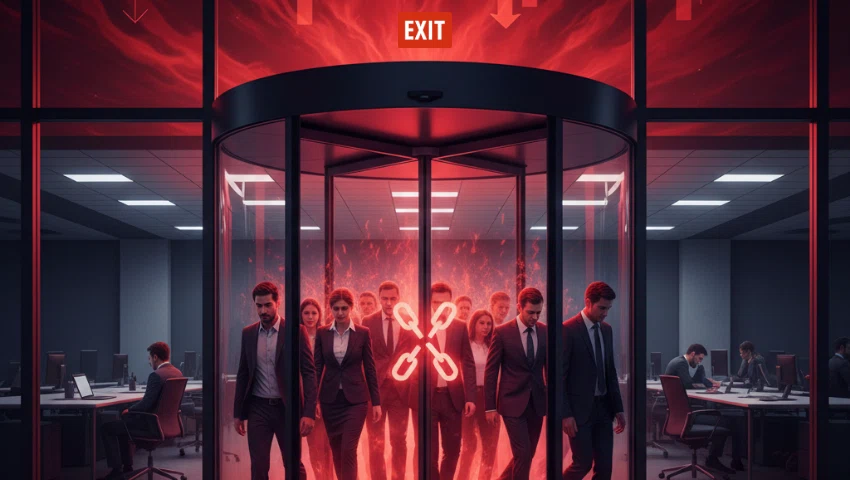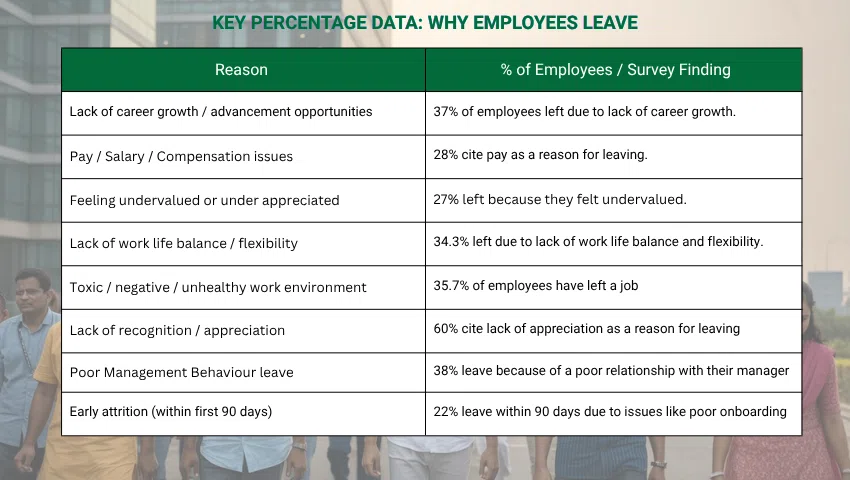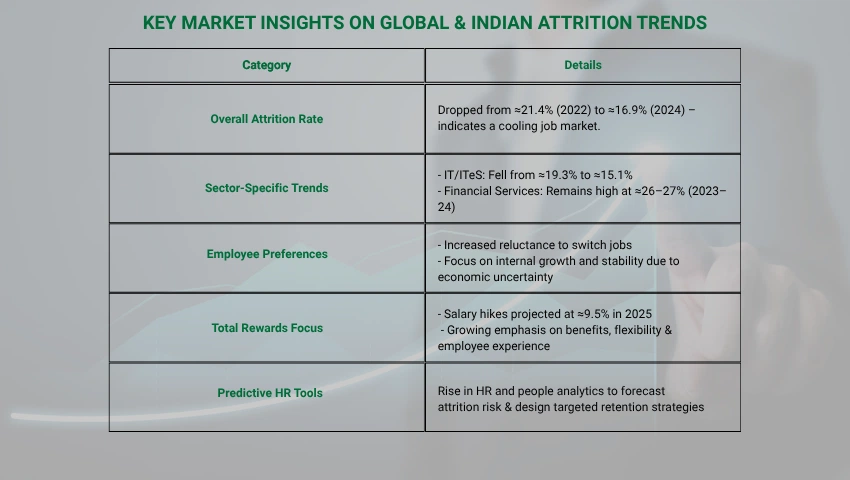-
 Call: +91-9677127317
Call: +91-9677127317
-
 Mail: hr@voltechgroup.com
Mail: hr@voltechgroup.com
Employee Attrition: Causes, Costs and Retention Fixes
- Home
- -
- Blog

Employee Attrition: Causes, Costs and Retention Fixes
- By Dhivin.T
- October 02, 2025
TL;DR: Employee attrition is a strategic challenge driven by factors like a lack of career growth opportunities, uncompetitive compensation/benefits, poor leadership, and an unhealthy work culture. High turnover incurs significant hidden costs beyond hiring, including loss of institutional knowledge and decreased team morale. To fix this, companies must invest in employee development, ensure competitive total rewards, train managers in empathetic leadership, actively promote work-life balance, consistently recognize achievements, and use Stay and Exit Interviews to proactively implement data-driven retention fixes, thereby building a loyal and stable workforce.
Introduction: The Strategic Imperative of Retention
Employee turnover is an increasing concern for organizations in every industry. In addition to incurring the obvious costs of searching for and onboarding new talent, high turnover rates impact the morale of other employees, productivity, and organizational reputation. Answering the question of how to improve turnover requires understanding the reasons employees leave and what organizations can do to keep their top talent in the organization over time.
🧑💻 Understanding the Root Causes of High Employee Turnover

1. Lack of Opportunities for Career Growth & Development:
• Employees often leave their organizations because they do not appreciably see a career path, nor do they see opportunities to upskill.
• When top performers feel their position has stagnated or they simply do not see any prospects for promotions - employees' morale erodes, they begin to job-hop, and the best employees leave for your competition.
2. Insufficient Compensation and Benefits:
• When pay is not at the market value (salary benchmarking), this is one of the leading causes for job-hopping.
• When Total Rewards Value Proposition is low, including healthcare plans, retirement plans and flexibility the final decision to stay at an organization is significantly influenced.
3. Poor Leadership and Management:
• The enduring phrase, "employees do not leave jobs, they leave managers" is still valid.
• Micromanagement, insufficient constructive feedback or patterns of toxic leadership grab high potential employees before they leave the organization.
4. Workplace Culture and Environment:
• Un-healthy work environments, lack of DEI or poor work-life balance result in an erosion of attrition.
• A match of personal employee values vs the company culture is a leading indicator of voluntary exits.
5. Insufficient Acknowledgment and Appreciation:
• Employees who sense they are not valued will be more inclined to seek acknowledgment in other places.
• Regular, meaningful acknowledgment programs have a real impact on stimulating both employee motivation and loyalty.
6. Burnout and Overwork:
• The combination of unrealistic expectations along with the ongoing pressure of high demands, leads to burnout both physically and emotionally.
• Remote and hybrid work settings increasingly blur the boundaries of work-life balance, which exacerbates this increasingly high-profile issue.

The Hidden and Tangible Costs of High Employee Turnover
The expenses of attrition are much more than just salary. Organizations must be aware of these hidden costs to make a case for how retention strategies may be uniquely beneficial:
• Recruitment and Onboarding: Recruiting is an expensive and time-consuming process that requires advertising, conducting interviews, and focusing on training for new employees.
• Loss of Institutional Knowledge: Leaving employees will take with them significant experience, historical knowledge, and knowledge of processes that are unique to that individual.
• Challenges to Team Morale and Cohesiveness: Continual turnover poses challenges to those who remain, leading to increased workload and a sense of instability.
• A Decline in Customer Satisfaction: High turnover can lead to detrimental service quality and decreased customer satisfaction, particularly, when the turnover is related to employees who interact with the customers.

What Organizations Can Do to Significantly Enhance Employee Retention
Retention is a strategic opportunity. Take informed action and invest time in the following to create an engaged, energized and high-performance workforce:
Invest in Employee Growth & Mobility:
• Facilitate ongoing training, mentor programs, and clearly defined pathways to provide employees for career growth.
• Offer benefits that employees want like creative work arrangements, mental health supports and comprehensive wellness programs.
Ensure Competitive Total Compensation:
• Frequently benchmark and evaluate salaries and benefits against the competition to ensure competitive total compensation.
• With AI adoption expected to transform 38 million jobs by 2030, Indian expertise directly supports Europe’s efforts to remain globally competitive in digital transformation.
Develop Strong and Empathetic Leaders:
• Provide training in emotional intelligence or coaching methods and effective people management skills.
• Develop open feedback loops and two-way communication between all levels of employees.
Create a Positive and Inclusive Work Environment:
• Ensure that your workplace is inclusive, respectful, and mission-driven with the same goal of giving every employee a voice in the decision-making process.
• Actively support work-life balance and make employee well-being a value proposition to your company's business model.
Recognize and Reward Successes:
• Formal and informal programs that regularly recognize employee successes, both for major accomplishments and minor daily successes.
• Recognizing success is dependent on the employee's comfort level with public commentary, financial incentives, and time off.
Use Stay Interviews and Exit Interviews:
• Stay Interviews are an active way to understand prescriptive information about what keeps engaged employees engaged and eventually what might cause them to leave.
• Using the data from Exit Interviews will allow your organization to create meaningful, systemic efforts to replace turnover with retention of quality employees.
Conclusion: Retention is a Strategic Imperative

Employee retention is more than an HR issue - it is also a business strategy. Companies that listen, adapt and always invest in their people are the companies that succeed and outperform. By counteracting the root causes of attrition and creating environments where people can grow and feel truly \ valued, businesses can turn the tide on turnover and develop a loyal, stable and high-performing workforce.
At Voltech HR Services, we know this well. Our experienced solutions go beyond meeting the hiring need to improve retention through aligning a talent strategy with long-term business goals. We assist organizations in establishing stronger teams and building sustainable success through our commitment to excellence.


Write Comment